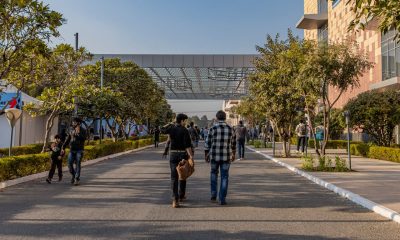News
Japanese engineer sought out by concert halls to shape sound
TOKYO –Behind some of the world’s most reputed concert halls is a Japanese engineer whose finesse in shaping sound is so perfectly unobtrusive that all listeners hear is the music –in all its subtlety, texture and fullness.
Yasuhisa Toyota’s talents are coveted as classical music venues are increasingly designed in “vineyard style,” where audiences surround the stage to hear the performers up close and enjoy an almost-interactive experience, feeling more like a part of the music and being able to be seen and respond to it.
Toyota’s Nagata Acoustics has just 20 employees globally, but it dominates acoustics work for halls in Japan and is expanding abroad. He’s designed the acoustics for orchestras in Los Angeles, Helsinki, Paris and Shanghai. Another of his projects, the Elbephilharmonie concert hall in Hamburg, opened Jan. 11.
Still, when asked to summarize the reason for success, Toyota hesitates. So many factors are involved in fine-tuning acoustics, and each hall has a different design, creating fresh challenges.
“No one can explain in one word why a Stradivarius violin sounds so beautiful, or how the way it was made may have shaped that beautiful sound,” Toyota said in a recent interview at his Tokyo home.
“Whether sound is beautiful, clear or pleasant is extremely complex,” he said. “So when we’re talking about acoustics in a concert hall, there is basically that space itself.”
Toyota, 64, is not a musician but was raised listening to and loving classical music. He founded his company in 1971. It has headquarters in Tokyo and Los Angeles, which is his main home these days as he oversees Nagata’s projects outside Japan
Toyota coined the expression “psycho-acoustics” to describe the importance of emotions and other senses in sound. Would a pink violin, for instance, sound as good as a brown one, he asks?
“There is discussion about a formula for acoustics because sound is invisible. People don’t ask those questions about visual design,” said Toyota, whose carefree flair, quick wit and laugh are unusual among Japanese of his usually staid generation.
At times sounding like a Zen monk when he talks about the art of sound, Toyota says crafting acoustics requires a thorough knowledge of building materials, close collaboration with architects, comprehension of musicians’ needs, computerized simulations, use of scale models of the halls and analysis of reverberating sound.
The thickness of a wall, its shape, material and curves, the fixtures hanging from the ceiling, and the musicians themselves all affect acoustics. In the old-style shoebox design of concert halls, where the audience sits in rows facing the stage, the sound is easier to control. The vineyard format is trickier.
David Howard, a bass clarinetist with the Los Angeles Philharmonic, has played in several halls Toyota has worked on and says he appreciates the direct, clear and full, and intimate nature of their sound.
“In that sense, Mr. Toyota hit a home run,” he said.
Apart from the just opened Elbephilharmonie, Toyota has done the acoustics for Stanford University’s Bing Concert Hall, Helzberg Hall at Kauffman Center for the Performing Arts in Kansas City, Missouri, and the Chamber Hall at the Museo Del Violino in Cremona, Italy. His first major overseas project was the Walt Disney Concert Hall, which opened in 2003, for the Los Angeles Philharmonic.
The acoustics of the hall the Los Angeles orchestra used before were so bad that musicians overplayed to compensate, and that carried over to other venues.
“The ideal environment,” Howard said, “is one where I can feel unencumbered in terms of being concerned about my individual sound, and I can just play, so that the ingredients are such that I don’t have to worry about it being beautiful enough, or loud enough, or clear enough, that those things are more or less taken care of for me, so that I can just make music.”
Toyota’s fame started with Tokyo’s majestic Suntory Hall, but its 1986 opening was a nightmare, he recalls.
It took time for the musicians to adjust to its finely tuned acoustics. That process can take several years. But these days, musical experts agree the acoustics in Suntory Hall are impeccable.
Toyota said he asks all musicians to play more softly while adjusting to a new venue where he’s worked.
“When all 80 people are nervous and playing in all directions, then there is utter chaos on stage,” he said.
Japan’s love for classical music and Toyota’s talent were evident at a recent Japan Philharmonic Orchestra performance at Suntory Hall of Bruckner’s “Symphony No. 8 in C minor.”
Kikue Sugimito, a long-time Japan Philharmonic season-ticket holder, remembers being awed by the sound quality when the orchestra moved from its previous venue to Suntory Hall.
“There is a transparence about the sound here,” she said.
Pietari Inkinen, the conductor, said the hall was so close to perfect any kind of piece could be played, inspiring the performers because listeners can feel the symphony “in their stomachs.”
“This is really one of the best halls in the world,” he said. “You can play unbelievably softly and it carries to the last row.”
The architect Frank Gehry, who worked with Toyota on Disney Hall, says the aim in designing a concert hall is to make the space comfortable and interactive for all in the room.
Gehry and Toyota donated their work to build a hall, opening in March, for Berlin’s Barenboim-Said Akademie, which was founded by conductor and pianist Daniel Barenboim and the American-Palestinian scholar Edward W. Said to educate and bring together young musicians, including Arabs and Israelis.
“In music, you’re taking sounds and putting them together to create beauty and a feeling. When you do a building, you’re taking inert materials and putting them together to create beauty and a feeling,” said Gehry, who admires Japanese culture, including gagaku music and architecture, and, especially, Toyota.
“You make the space comfortable, interactive and humane so that people feel together in the room and people feel together with the orchestra. The orchestra feels the relationship with the people. And it makes it better. That was what we tried to do. We could talk about it that way,” said Gehry in a telephone interview from Los Angeles.
“I love working with him –an enriching treat beyond belief,” he said.
Although architects and acousticians sometimes don’t get along, as they infringe by definition on each other’s turf, Toyota told a story about the cross-cultural collaborative relationship he has with Gehry, joking about sharing blame equally if Disney Hall were to fail.
“So he tells me, ‘Yasu, if things don’t go well, let’s commit harakiri together. But you have to do it first, and I’m following because I have no idea how to do it.’ My response was, ‘Frank, you have to do it first. If I did, there will be no one who can help you. I can help you. You should go first. I’m going after you.’ “





















